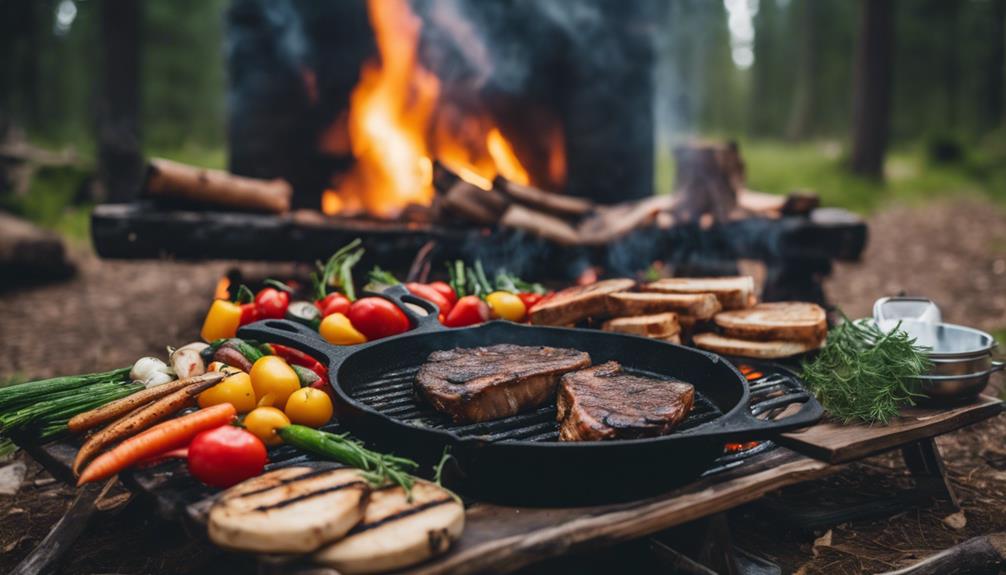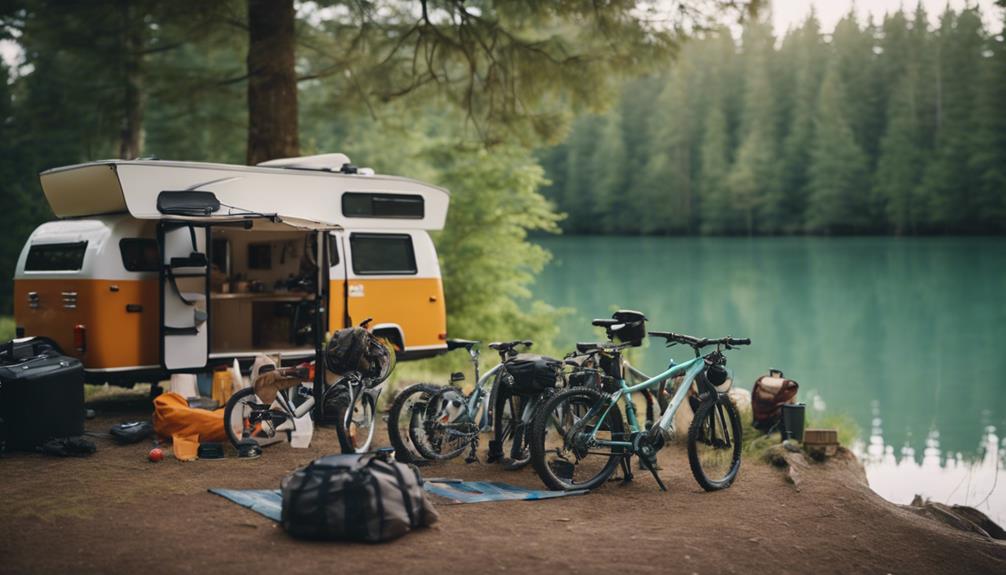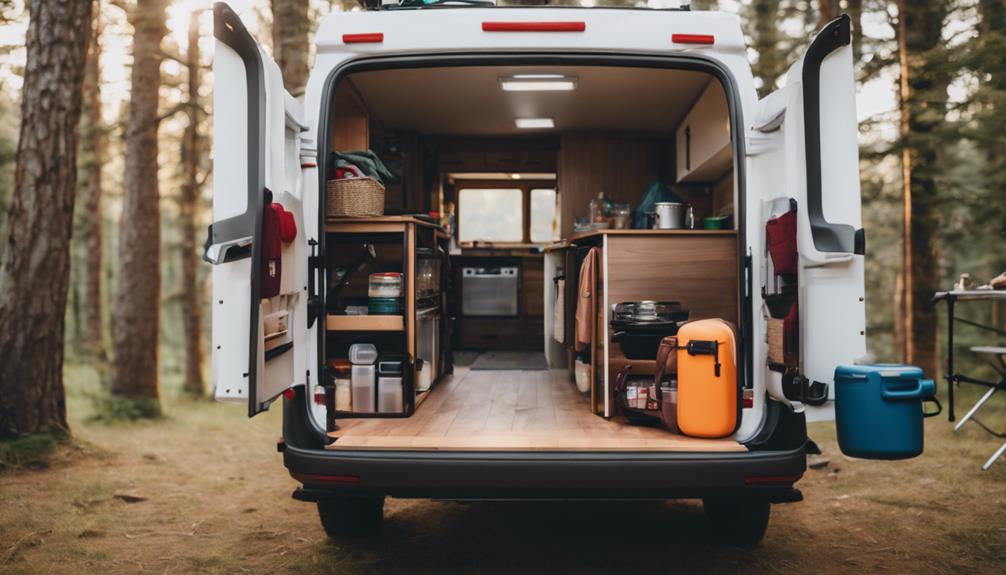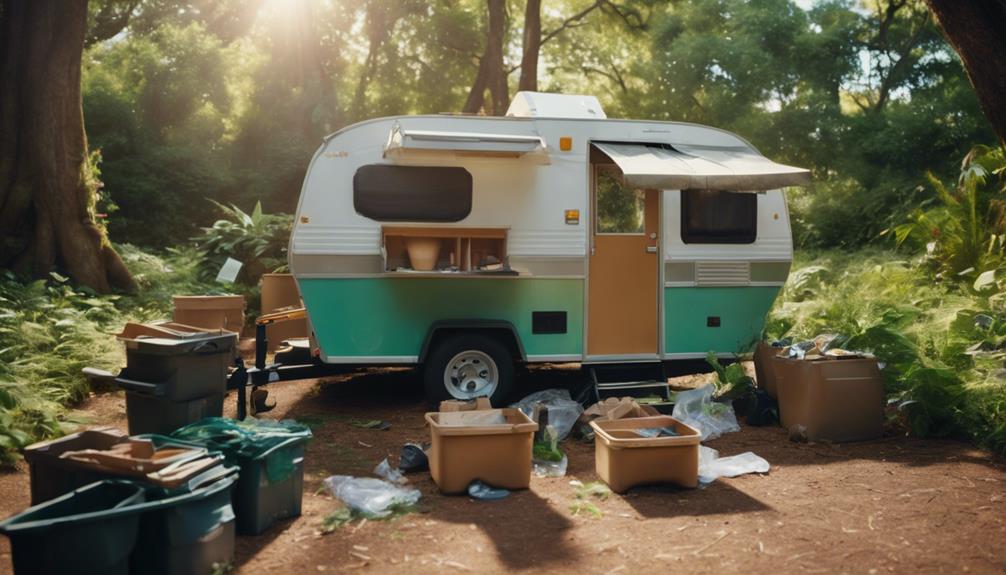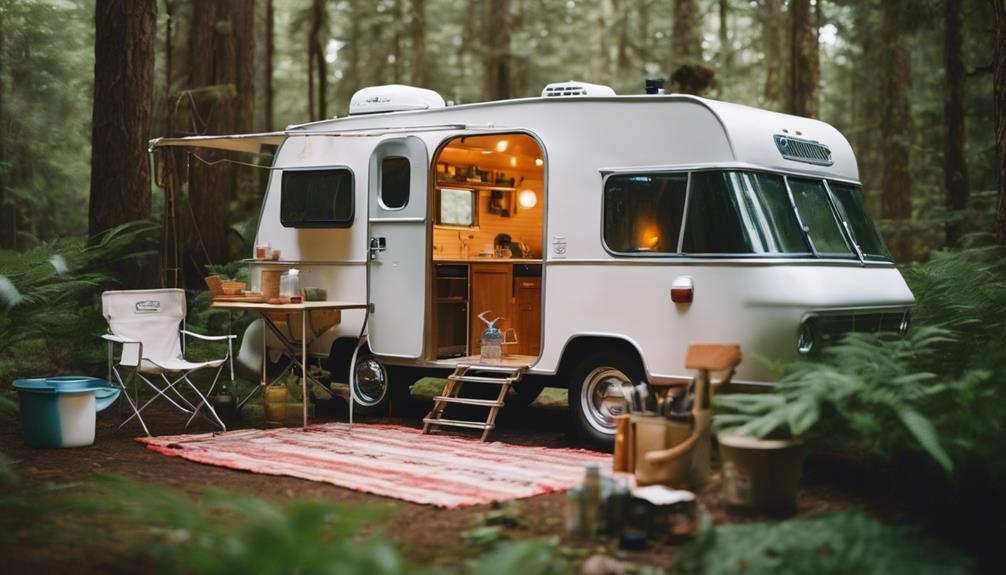To make your pop-up camper warmer, start with effective heating options like a Buddy propane heater or heavy-duty electric heater. Insulate using Reflectix inserts for windows and seal gaps with cotton balls to prevent drafts. Layer your sleeping gear, using warm sleeping bags rated for colder temperatures and heated mattress pads for extra comfort. Don't forget to monitor ventilation while using heaters to avoid carbon monoxide buildup. Regularly check propane levels and inspect for air leaks to maintain efficiency. Want more tips to stay cozy on your camping adventures? You're in the right place for all the details!
Key Takeaways
- Use propane heaters for effective warmth in cold conditions, ensuring proper ventilation to avoid carbon monoxide buildup.
- Insulate bunkend windows with Reflectix inserts to significantly reduce heat loss and prevent condensation.
- Layer sleeping arrangements with thermal clothing and sleeping bags rated for 20°F or lower for optimal nighttime comfort.
- Regularly check for air leaks and seal gaps with cotton balls to enhance warmth retention in your camper.
Heating Options for Cold Weather
When the temperatures drop, having the right heating options for your pop-up camper can make all the difference in keeping you warm and comfortable. One of the best choices is a propane heater, which effectively warms small spaces even in frigid conditions.
If you're camping in temperatures below 40°F, a buddy propane heater is an excellent backup option. Just remember to monitor propane levels and guarantee proper ventilation to avoid any carbon monoxide risks.
Electric heaters can serve as supplementary heating sources, but be cautious. Use heavy-duty extension cords to prevent overload and guarantee safety.
If you're lucky enough to have electric hook-ups at your campsite, consider adding a heated mattress pad or an electric blanket for extra comfort as you sleep. These options help you stay warm without relying solely on the heater, minimizing the risk of condensation issues that can arise from excessive moisture in the air.
Effective Insulation Techniques
Effective insulation techniques can greatly enhance your pop-up camper's ability to retain heat and keep you comfortable during cold weather. One of the most effective methods is using Reflectix inserts for your bunkend windows. These inserts drastically reduce heat loss and minimize condensation buildup, creating a cozier environment.
Additionally, sealing small gaps between the camper's tenting and the body with cotton balls helps prevent drafts, which is essential for overall warmth retention. Installing exterior bunkend covers also creates a dead air space, acting as an additional barrier against cold air infiltration.
Don't overlook the importance of rugs and thermal curtains. They contribute to heat retention by providing extra insulation on your floors and windows, effectively preventing heat loss.
Warm Sleeping Arrangements

Creating warm sleeping arrangements in your pop-up camper guarantees a cozy night's rest, even in chilly conditions. Start by investing in warm sleeping bags rated for at least 20 degrees Fahrenheit. These will provide essential warmth as temperatures drop. Layering your clothing with thermal undergarments and sweats adds extra insulation, helping you retain body heat throughout the night.
Consider using heated mattress pads to customize warmth for you and your partner, ensuring everyone's comfort. If you prefer a non-electric option, toss on a Sherpa-lined blanket over your sleeping bag for added coziness without relying on power.
To further enhance your sleeping environment, pull curtains or use insulated covers on unused bunk ends. This prevents drafts and keeps the heat contained, creating a snug atmosphere. If you notice any drafts sneaking in, address them promptly to maintain that cozy sleeping environment you desire.
With these strategies, you'll not only keep warm but also enjoy a restful sleep, making your camping experience much more enjoyable. So, gear up and prepare your pop-up camper for those chilly nights ahead!
Safety Precautions for Heating
To guarantee your safety while heating your pop-up camper, always install carbon monoxide detectors, especially if you're using propane heaters. This vital step protects you from potential gas leaks that can lead to serious health risks.
Here are some essential safety precautions to follow:
- Position electric heaters away from flammable materials like blankets and bedding to prevent fire hazards.
- Ensure proper ventilation when using propane heaters to minimize carbon monoxide buildup and reduce humidity levels.
- Conduct regular equipment checks to verify that all heating devices are functioning correctly and have secure connections.
- Avoid sleeping with heaters running inside the camper, as this can expose you to harmful carbon monoxide levels.
Managing Condensation Issues

Managing condensation in your pop-up camper is essential for maintaining a comfortable and healthy environment, especially during winter trips. Proper ventilation plays a significant role in controlling moisture levels.
Keep vents cracked and unzip canvas to promote airflow, helping to reduce humidity inside the camper. Remember, activities like cooking and even breathing generate substantial moisture, so utilize ceiling vents and lower windows for effective air exchange.
Cold surfaces naturally attract moisture, leading to potential damage. Insulating these areas with materials like Reflectix can help minimize condensation and keep your camper cozy. Regularly monitor and adjust humidity levels to prevent mold and rot, ensuring a healthier living space throughout your winter adventures.
Additionally, utilizing rugs and blankets to block drafts can help maintain a stable temperature. A consistent temperature reduces the chances of condensation forming, as fluctuations can exacerbate moisture issues.
Fuel and Power Considerations
Maintaining warmth in your pop-up camper during winter trips requires careful attention to fuel and power considerations, particularly as condensation issues can worsen in cold environments. Here are some tips to keep in mind:
- Make certain you have an adequate supply of propane; running out could lead to freezing conditions.
- Check your RV battery's power levels regularly, as it may not be sufficient for heating systems in cold weather.
- Consider having a backup power source like an inverter generator to extend your battery life.
- If possible, utilize electric hookups in campgrounds, which can be more economical than burning propane.
For a three-day trip, plan to have at least one full propane bottle on hand, as you might consume about 1.5 bottles due to significant heating needs.
Community Camping Insights

While camping in cold weather, many experienced campers emphasize the need for effective warming strategies and share valuable insights from their own trips. Community discussions have highlighted the importance of packing additional heating items and using multiple sources of warmth. Electric heaters, when paired with propane options, often provide a reliable heating setup.
To guarantee your pop-up camper stays warm enough to sleep comfortably, consider these tips:
| Insulation Technique | Benefits |
|---|---|
| Reflectix | Reduces heat loss |
| PUGS (Pop Up Gizmos) | Minimizes condensation |
| Layered sleeping bags | Provides extra warmth |
| Thermal curtains | Blocks cold drafts |
Many campers recommend experimenting with different heating setups in controlled conditions before your trip. This trial and error approach helps you identify the most effective techniques for your specific needs. By focusing on insulation and strategic heating, you can considerably enhance your camping experience, ensuring you stay cozy even in chilly temperatures. Embrace these community insights, and you'll be well-prepared for your next cold weather adventure!
Personal Experiences and Tips
When you're camping in cold weather, finding effective heating solutions is essential to staying warm.
Insulating your pop-up camper and layering your clothing can make a significant difference in your comfort.
Let's explore some personal experiences and tips to help you keep the chill at bay.
Effective Heating Solutions
One of the best ways to keep your pop-up camper cozy is by using a Buddy propane heater, which can heat the space effectively even in chilly temperatures. This heater can keep you comfortable even when the mercury dips to the mid-20s.
However, to enhance your cold-weather camping experience, consider these additional heating solutions:
- Electric heated mattress pads for that extra layer of warmth.
- Reflectix to insulate your bunkend windows and retain heat.
- Warm sleeping bags rated for 20 degrees or lower to keep you snug at night.
- Propane levels should be monitored regularly to avoid running out unexpectedly.
Insulation Techniques for Warmth
Insulating your pop-up camper effectively can make a world of difference in keeping it warm during chilly nights. Start by utilizing Reflectix inserts for your bunkend windows. These reflective materials help retain heat, making your camper much cozier.
You should also consider employing PUGS (Pop Up Gizmos) on the roof and sides. They create a thermal barrier, considerably reducing heat loss and enhancing warmth retention.
Don't overlook small gaps that can lead to air leaks between the tenting and the pop-up. Sealing these with cotton balls can prevent drafts, ensuring that your heat source stays efficient.
Adding exterior bunkend covers is another great tip; they create dead air space, acting as an additional layer of insulation against the cold.
Lastly, make it a habit to regularly check for air leaks around windows and seals. Addressing these leaks can substantially improve your camper's heating efficiency, keeping you cozy throughout your adventures.
Layering for Comfort
Effective insulation sets the stage for staying warm, but layering your clothing is just as important for comfort in a pop-up camper. When you layer effectively, you can better regulate your body temperature and adapt to the varying conditions inside the camper.
Start with thermal tops and bottoms as your base layers to trap heat close to your skin.
Here are some essentials to take into account:
- Two sleeping bags, one inside the other, for added warmth
- Sherpa-lined blankets for extra coziness without electricity
- Electric heated mattress pads for a warm sleeping surface
- Sweats or fleece over your base layers to trap more heat
Using multiple layers allows you to adjust your clothing according to the temperature. If you start feeling too warm, you can easily remove a layer.
Remember, staying warm isn't just about the materials you use; it's about how you combine them.
With these tips, you'll create a snug, comfortable sleeping environment in your pop-up camper, making those chilly nights much more enjoyable.
Preparing Your Camper for Winter

Preparing your pop-up camper for winter means taking proactive steps to guarantee you stay warm and comfortable during your cold-weather adventures.
Start by insulating your camper with Reflectix inserts for the windows and exterior bunkend covers. This creates dead air space, greatly improving heat retention. For added thermal protection, consider using PUGS (Pop Up Gizmos) on the bunkends to reduce heat loss.
Regularly check for air leaks around windows and seals. Even small gaps can drastically reduce your heating efficiency and let cold air in. Make sure your heating systems are properly winterized and in good working condition. Before you head out, monitor your propane levels to avoid running out in frigid temperatures.
Equip your camper with supplemental heating options like electric blankets or heated mattress pads for those colder nights. These additional layers of warmth can make a considerable difference in your comfort.
Frequently Asked Questions
How to Stay Warm in a Pop-Up Camper?
To stay warm in a pop-up camper, use a mix of propane and electric heaters, insulate with Reflectix, layer your clothing, sleep in quality bags, and maintain ventilation to prevent condensation while keeping heat inside.
How Can I Make My Camper Warmer in the Winter?
To make your camper warmer in winter, use Reflectix for windows, employ a propane furnace, and layer bedding with warm sleeping bags. Don't forget to seal gaps and guarantee proper ventilation to avoid condensation.
How Do You Keep an RV Warm at Night?
To keep your RV warm at night, set your furnace around 50-55°F, use insulated window covers, layer your bedding, monitor propane levels, and guarantee proper ventilation to reduce condensation while staying cozy.
Can You Insulate a Pop-Up Camper?
Yes, you can insulate a pop-up camper effectively. Use Reflectix inserts for windows, add PUGS for extra canvas insulation, seal gaps with cotton balls, and check for air leaks to enhance warmth and comfort.
Conclusion
By implementing these strategies, you can transform your pop-up camper into a cozy retreat, even in the coldest weather.
Did you know that properly insulating your camper can reduce heat loss by up to 40%? This not only keeps you warm but also helps you save on fuel and energy costs.
With the right preparation and precautions, you'll enjoy a comfortable camping experience, no matter the season.
So gear up and embrace the winter wonderland outside!


